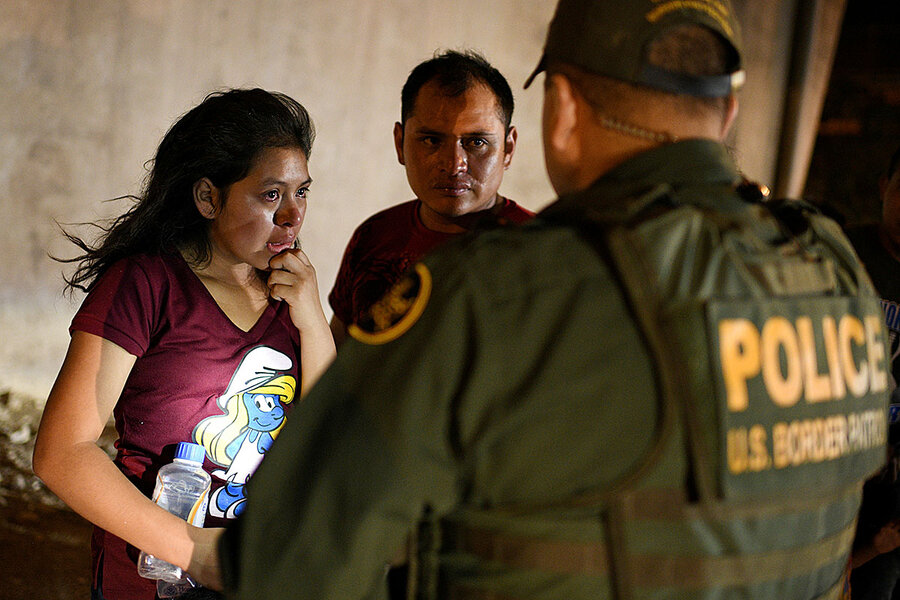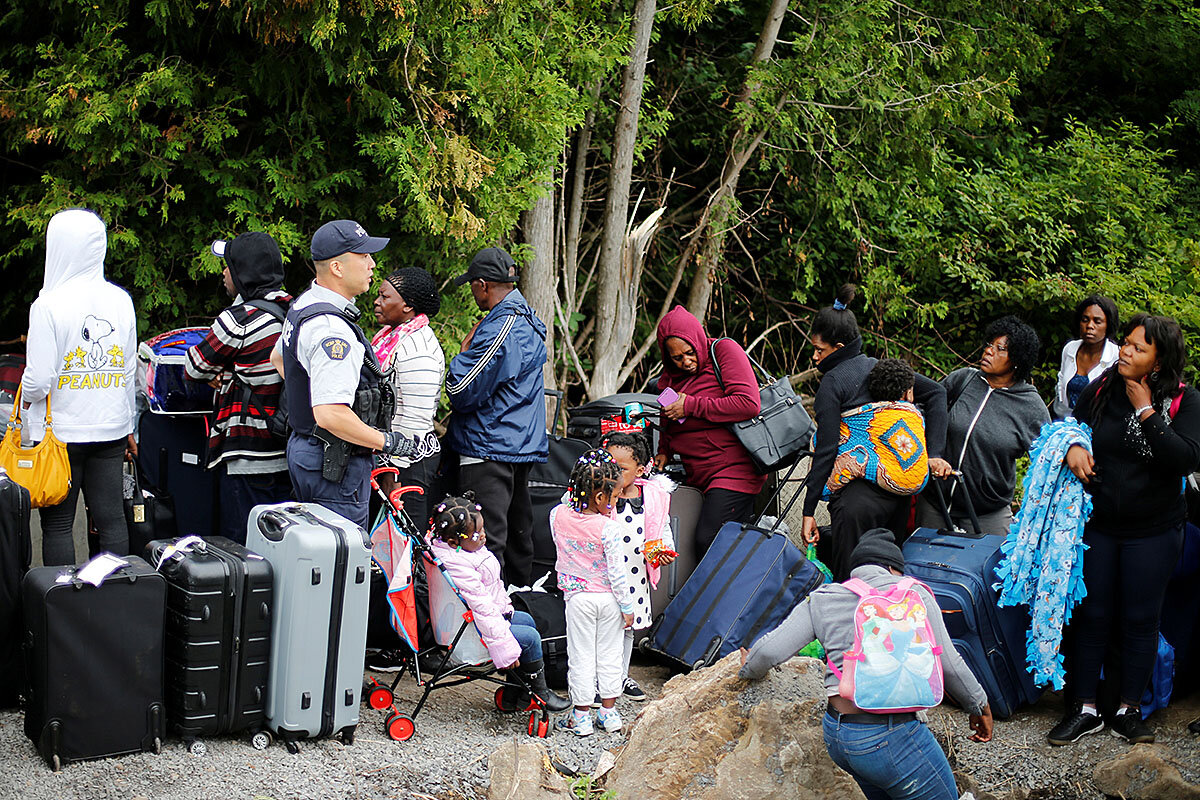Canada asks, ‘Why aren’t we helping more Central American refugees?’
Loading...
| Kitchener, Ontario
In 2018, Canada overtook the United States as the world’s most welcoming country to refugees – in large part thanks to President Donald Trump’s closed-door policies toward asylum-seekers, particularly those arriving on the U.S.-Mexico border fleeing violence in Guatemala, Honduras, and El Salvador. But despite Canada’s reputation, few Central Americans are finding refuge within its borders, and activists are asking why.
It’s hard for Central Americans to seek Canadian asylum in the first place, because of the “Safe Third Country Agreement” that the U.S. and Canada signed after 9/11. Under the deal, an asylum-seeker who places a claim in the U.S. and then tries to do so at the border in Canada will be turned back. In Canada, the deal has been controversial since it went into effect, and has received increasing critical attention at home since Mr. Trump’s various measures to shut down the asylum process.
“Since Trump came into power it has been turned topsy-turvy,” says Lloyd Axworthy, a former Canadian minister of foreign affairs. “So how can we use their refugee system to be the conduit for refugees coming to Canada through the United States when they no longer want to deal with refugees?”
Why We Wrote This
Canada has a long history of opening its doors to the world’s refugees. But how has it ended up prioritizing some asylum-seekers while others in its American backyard still go wanting?
“This is it; this was their landing place,” says Monika Oviedo, as she arrives at Reception House, a three-story brick home on a leafy street of this diverse city 40 miles west of Toronto. It’s where her parents spent their first two weeks in Canada with her older brother, then 5, when they arrived in 1991 as refugees from El Salvador, fleeing civil war and the threat of the military and paramilitary death squads.
The house sits across from Victoria Park Lake, which lent Ms. Oviedo’s mother meditative peace during a time of upheaval in her life, and is still running today. But it mainly serves government-assisted refugees from Syria, other parts of the Middle East, and East and Central Africa. There are no Central Americans living there now.
That has not gone unnoticed in a country that has grabbed global attention for its generous welcome of refugees, especially as the United States under President Donald Trump continues to shut out families fleeing violence in Guatemala, Honduras, and El Salvador. Last month the Trump administration announced a rule to hold asylum-seeking children with their families indefinitely in detention, up from 20 days. That’s after a series of measures to stop immigration flows altogether, including separating children from their parents at the border.
Why We Wrote This
Canada has a long history of opening its doors to the world’s refugees. But how has it ended up prioritizing some asylum-seekers while others in its American backyard still go wanting?
“As someone whose family came as refugees, with the crisis at the U.S.-Mexico border and the crisis in Central America, Canada’s absence and lack of any kind of response has been gnawing away at me for a long time,” Ms. Oviedo says.
Ms. Oviedo and the activist group she helped form this summer, the Coalition for Northern Central America (CNCA), think Ottawa needs to increase resettlement of Central Americans who are living out a humanitarian emergency. So do officials from the United Nations Refugee Agency (UNHCR), particularly to help ease the current burden on Mexico, where many Central American asylum seekers are stuck. Doing more could include resettling more refugees from the region, as Canada did during the peak of the Syrian war, or fighting against U.S. policy that’s making it hard for them to arrive in Canada, via Mexico and the U.S., to seek asylum.
“Canada has been very responsive, the response on Syrian refugees was probably the best in the world,” says Lloyd Axworthy, a former Canadian minister of Foreign Affairs and now chair of the World Refugee Council. “So that’s why many of us are kind of perplexed. Why are we not responding the same way to something in our own neighborhood?”
Topsy-turvy
The number of asylum seekers from the “Northern Triangle” (Guatemala, El Salvador, and Honduras) rose by 30%, to more than 311,000, in 2018. Of those who make it to Canada, government data shows a significant majority are accepted into the country. Indeed, on World Refugee Day this June, the UNHCR announced Canada was the world’s most generous country for resettlement in 2018, the first time the U.S. failed to top the list since the 1950s.
But it’s hard for Central Americans to seek Canadian asylum in the first place, in large part because of the “Safe Third Country Agreement” that the U.S. and Canada signed after 9/11. Under the deal, an asylum seeker who places a claim in the U.S. and then tries to do so at the border in Canada will be turned back. Mr. Trump has pushed for “safe third party” deals with Guatemala and Mexico, moves that have been panned as an attempt to further shut out asylum seekers.
In Canada, the deal has been controversial since it went into effect in 2004. The most vulnerable Central Americans, specifically those who can’t access a visa to get here in the first place, don't have a safe option to seek asylum says Patricia Landolt, a professor of global migration at the University of Toronto. The agreement has received increasing critical attention at home since Mr. Trump’s various measures to shut down the asylum process.
“At the time [of the agreement], I think we had a fairly common base of values and procedures with the United States refugee system. Since Trump came into power it has been turned topsy-turvy,” says Mr. Axworthy. “So how can we use their refugee system to be the conduit for refugees coming to Canada through the United States when they no longer want to deal with refugees?”
More resettlement of refugees could help bypass the mounting pressures on the U.S.-Mexico border.
For decades Canada was a haven for tens of thousands of Latin Americans – from those fleeing the dictatorship of Augusto Pinochet in Chile (including Ms. Landolt’s family in 1974), to Central Americans fleeing civil war in the 1980s and early ‘90s, to drug-fueled violence in Colombia in the ‘90s.
That hospitality has left a mark on Kitchener, where vibrant eateries serve the Salvadoran national specialty, pupusas (corn flatbread), and grocers sell plantains and banana leaves. Andres Guerrero, who arrived in 1990 with his young family and owns the bustling Pupuseria Latinos, says what is happening in the U.S. is so upsetting that he refuses to watch the news. His eldest son, also Andres Guerrero, watches, but calls it “heartbreaking.”
Ms. Oviedo says that Canada welcomed refugees from El Salvador during the Cold War in a stance against U.S. policy to back violent Central American military and paramilitary forces at the time. Today she and many others worry that Canada is not standing up to Mr. Trump because Canada has so much at stake economically.
“Political shift we’re not seeing”
While Canada surpassed the U.S. last year in resettlement, that is mostly because the U.S. dramatically stepped back from previous years. The CNCA says it is here that Canada could fill a “hole.” It highlighted one UNHCR-coordinated program, under which Canada has only resettled 11 Northern Triangle refugees. The coalition has circulated a petition to pressure Ottawa to use mechanisms already in place to open up resettlement pathways.
UNHCR has advocated for Canada to increase resettlement of the most vulnerable from Mexico too, like members of the LGBTQ community. “Canada has always been a very strong partner for us. But a refocus on Central America or that part of the world would be most welcome,” says Jean-Nicolas Beuze, the UNHCR Representative in Canada.
Canada has provided over $50 million (Canadian; $37.5 million U.S.) to the Northern Triangle for development to “address the push factors of irregular migration such as violence, insecurity and poverty, especially towards vulnerable populations such as women and girls,” says Immigration, Refugees and Citizenship Canada, the government's immigration department, in a statement. They add they’ve been working with UNHCR to provide training, technical assistance, and tools to help Mexico process a growing number of asylum claims.
In the meantime, polarized immigration politics shapes understanding of what persecution is – and doors are closed everywhere. Many continue to see the plight of Central Americans as one of poverty and violence but not persecution.
Ms. Landolt argues that gang- and drug-fueled violence in Central America and Mexico today should be seen as a humanitarian crisis and, for the many who fear direct persecution by the state and para-state forces, as a refugee crisis. Instead, she sees politicians denying the flight from violence as an exodus of refugees fleeing insecurity.
“This is the kind of political shift that we’re not seeing. We’re not seeing it in Canada. We’re certainly not seeing it in the United States. I think that’s what we would need to work towards.”










